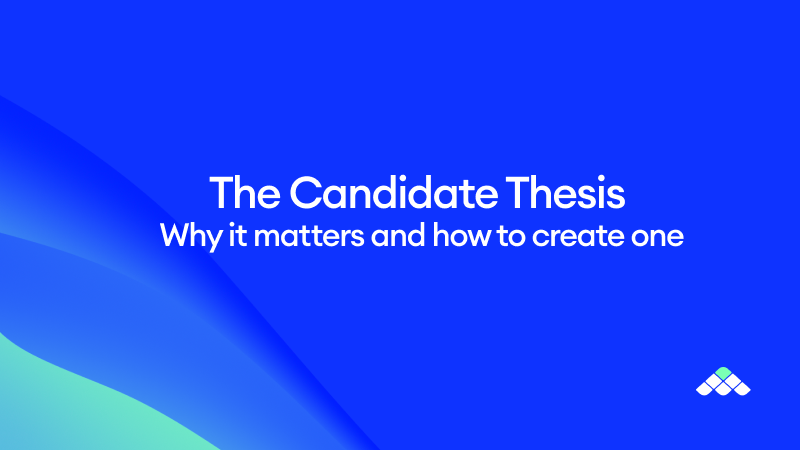When we build products, we're rigorous and deliberate about the decisions we make. It’s widely accepted that we can’t move forward without learning from past work, so we hold retrospectives where teams reflect on how initial hypotheses have played out over time. On the other hand, hiring is the most outcome-defining activity an organization can undertake, yet people decisions rarely get the same level of reflection and analysis as other important decisions. I believe one of the most impactful things we should be doing to bring more rigor and intention to hiring is writing candidate theses.
What is a candidate thesis and why does it matter?
A candidate thesis is a hiring manager's opinion on why a candidate is a good fit. It's written as part of making a hiring decision, before a candidate has started work. It should include what success and failure would look like for this person in the first six months, including the ultimate upside—or downside—you expect from them.
A candidate thesis can be valuable in a number of ways:
- When the hiring model is centralized and candidates are interviewed for a range of potential teams and roles, a candidate thesis helps make sure people are resourced appropriately. When you have a clear idea of what will enable a candidate to thrive, it's much easier to identify a placement that will likely lead to mutual success.
- It’s a helpful document to review just before a new hire starts to remind yourself where their strengths and weaknesses lie and what you expect success will look like.
- Most importantly, a candidate thesis should be leveraged as a powerful retrospective tool to optimize future hiring processes. More on this later.
How to write a candidate thesis
The thesis is effectively a highly-synthesized form of your scorecards, which is why it’s so important to have a strong process in place to gather opinionated, informed candidate analysis (for more on that, check out our recent guide).
A candidate thesis should be one to two paragraphs summarizing:
- A candidate’s key attributes as identified throughout the interview process. These might be the same attributes that were part of your assessment rubric, or they could be new ones that you uncovered in the interviews.
- A few examples of how the candidate has demonstrated each attribute.
- Your assessment of how each attribute could manifest as a strength and weakness in the candidate’s work. For example, you might have deduced that one salient attribute of a candidate is their high level of empathy. That could manifest itself as a strength in that you expect the candidate to be collaborative and easy to work with. On the flip side, you might see a risk that because they dislike confrontation, they could struggle to make effective decisions.
Once you have laid out the attributes and their implications, synthesize these findings into a concise hypothesis of what success and failure paths would look like in the candidate’s first six months at your company. You might want to layer in other frameworks to make sense of the data points. For example, I find Daniel Pink’s motivation theory of autonomy, mastery, and purpose helpful in better understanding what drives a person to succeed and what types of environments will provide them what they need to succeed.
The importance of the retrospective
A candidate thesis is about paying it forward. The real value of the thesis lies in revisiting it after a few months and using those learnings to improve future hiring decisions. I recommend holding a thesis retrospective at the six month mark. The hiring manager should drive this meeting and include partners in recruiting and the broader hiring committee. It’s worth noting that a candidate thesis is a sensitive document and shouldn’t be shared broadly. For that reason, keep this ritual contained to a small, trusted group.
This meeting should cover a frank discussion of how a recent hire has fared compared to your initial expectations, including:
- How has this hire followed, or diverged from, the success or failure paths you originally hypothesized? You want to understand how a hire’s actual trajectory has compared against the predictions you initially had based on the information gleaned in the interview process.
- How can this hiring decision inform future pattern matching? With successful hires, the retrospective process should help improve confidence in your decision making and ability to identify desired attributes in candidates. In the case of mis-hires, the retrospective should shed light on where you got things wrong and what you might have missed, or misjudged, during the interview process. These learnings are invaluable for making sure to avoid the same missteps for future hires.
- What does this hire reveal about your values? The retrospective often reveals interesting gaps between what you say you value and what you actually value in practice. For example, you might find that you cared a lot about a particular attribute during the interview process, but in reality a hire ultimately failed because they didn’t possess some other attribute that you hadn’t previously thought was important. Similarly, a hire might be succeeding due to an attribute you hadn’t even considered during the interview process. Continually reflecting on what has made a successful or unsuccessful member of your team is the best way to arrive at a set of values that are reflective of what you actually care about.
The candidate thesis is a powerful, but underleveraged, tool to optimize your hiring process. Deliberately documenting why you hire people and then thoughtfully reflecting on what was right or wrong about that decision will yield rich learnings that sharpen your ability to identify and attract more of the right people.


